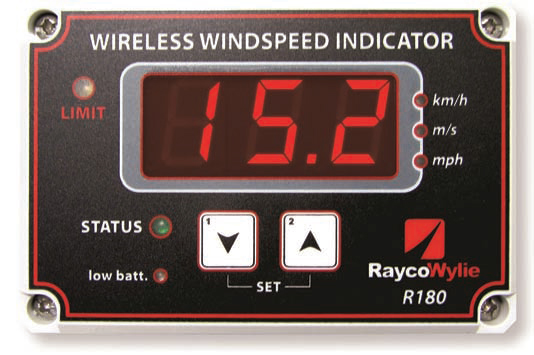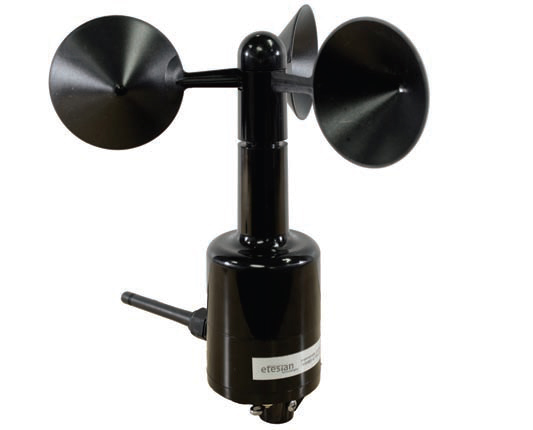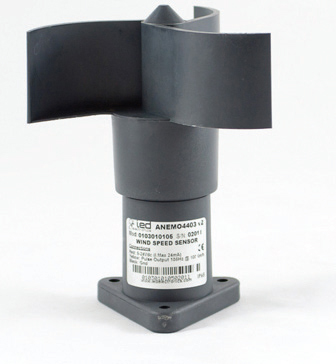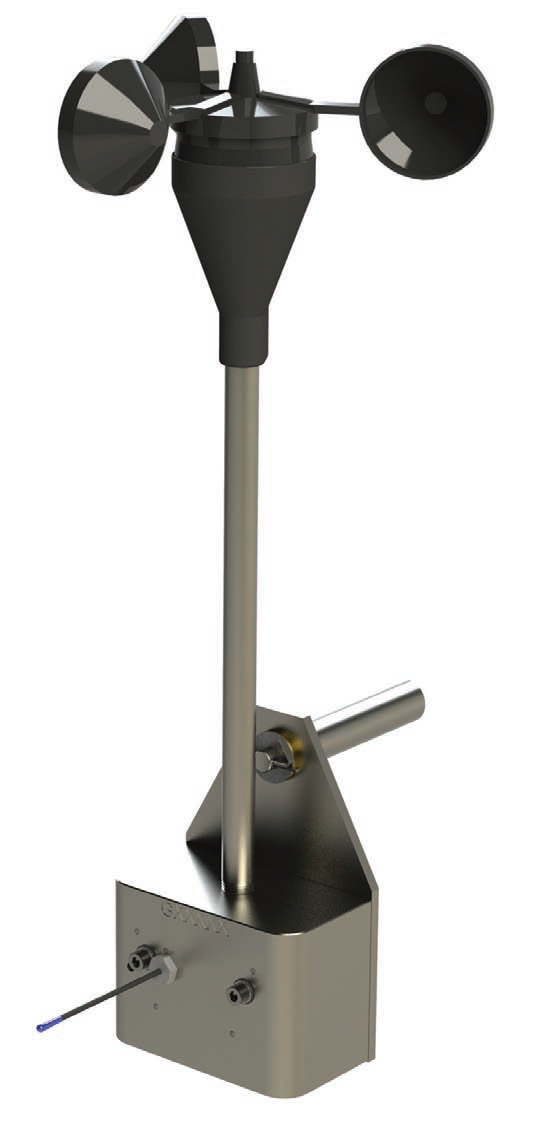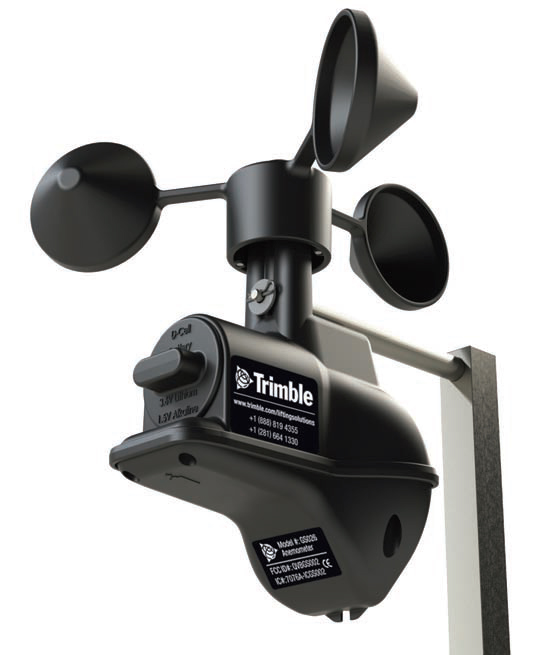Watching the weather
21 June 2016Crawler manufacturers and best practice guides recommend the use of well-placed anemometers as one element in keeping crawlers safe from high winds. Here, we round up some of the equipment on offer.
SMIE offers wind speed measurements, supplying the site personnel with the necessary information in real time. They are designed to take the necessary preventive measures against the possible risks, for example uncontrollable load movement or in the worst case the overturning of the machines.
SMIE can provide a range of wind speed indicators and alarms to respond to all jobsite needs: measurements of wind speed, transmission of the measured value, either by cable or radio, towards a remote point; display of the wind speed.
As wind speed indicator and alarm, there is RAN41 display, which includes display in km/h, barograph 10LEDs, power supply 230 VAC or 400 Vac with power consumption of 18 W in addition to magnetic fixation and IP55. This device can guarantee accuracy 7 at 25 per cent and 72 km/h.
The KSANE model provides two alarm thresholds, the pre-alarm 50 km/h and the alarm 70 km/h.
Its features include power supply 480, 400, 230, 115 and 48 VAC, flashing red and amber with 2W at 75 pulsations/m, siren output 110 db at 1m, as well as self test upon start-up.
Additionally, all the wind speed indicators and alarms are supplied with the TR41/ TR42 wind sensor, comprising a cable with length of 20m and 40m and the output signal is given as DC voltage.
The company says RL10 wireless transmission system allows one or more TR41 wind speeds to be connected to one or more indicators.
Features of the RL10 include a frequency band with 868 MHz at 25mW, a battery-powered standard of 1.5V –LR14 type and a possibility of external power supply 10-30 VDC. With regards to the autonomy, the transmitter RL10E has 50 weeks and the receiver RL10R 2 weeks.
Trimble
Trimble company offers the new LSIRobway GS026 wind speed sensor, which introduces a user-focused and cost-effective design to the market.
Design features include a communication range of 4,600 feet and a measurement range from 0 to 150 mph. The GS320 display shows a maximum wind speed of 99 mph or 159.3 km/h with a typical accuracy of plus or minus 3 mph.
The wind cup head assembly has two embedded magnets that pass by a reed switch in the wind speed body as the wind speed head assembly turns, producing an accurate wind value.
The GS020 Wind Speed Sensor pivots on its steel-mounting bracket, useful in cranes where the structure it is mounted on moves up and down. This keeps the wind cups perpendicular to the wind, the ideal angle to accurately measure the wind speed.
The company says the GS020 Wireless Anemometer gives proven and effective monitoring for crane applications, offering an operating range of 4000 or 1300m. This anemometer is designed to work within uncompromising environment, for example wind turbines.
It can be installed on long boom lattice cranes. While a 500’ lattice boom can creates problems in other systems, an LSI system will efficiently communicate with the cab mounted display, the company says.
The GS020 Anemometer works with the Wireless Gateway, which provides direct communication to a PC, PLC or proprietary display/controller.
A key installation tip is to ensure that the wind speed sensor is placed at the boom tip of the crane, as compared to the top of the crane cab. There is a vast difference of wind speed at 20’ off of the ground versus a boom tip that is 200’ off of the ground.
The company says: “There have been many avoidable accidents due to a cab-mounted wind speed sensor.”
Rayco Wylie
Rayco Wylie offers the wireless wind speed indicator R180, which measures and indicates the wind speed to the crane operator. The system has an adjustable maximum wind speed limit.
In addition, a visual and audible alarm works with direct sequence spread spectrum transmission technology for an enhanced range of operation and better RFI resistance.
This wind speed indicator uses lithium batteries that last up to two years and take less than 30 minutes to install.
This anemometer is designed to be easy to read, supplying a weather proof display. There are audible and visible alarms on the display in addition to fast and easy sensor replacement without a complete system calibration.
IED Electronics
IED Electronics also offers a range of wind speed devices, the Anemo 5H25 and the Anemo 4403.
The 5H25 is designed for any system to know wind speed in extreme conditions, with ice and snow included, such as construction cranes and wind turbines. As an improved version of the 4H25, the new model can provide body and ballets more resistant in outdoor. The heater heats only when it’s necessary without wasting energy. The heater power range is from 15V dc to 24Vdc. The Anemo 5H25 is usually connected to devices such as tachometers, PLCs and dataloggers, for wind speed visualization, alarm thresholds programming and/or wind speed data acquisition.
The 4403 is designed for any system that requires wind speed data and a common application consists of connecting the sensor to a tachometer, viewing the wind speed and programming alarms to be triggered at various speeds.
Etesian
Etesian Technologies recently launched a new wireless anemometer sensor. The Breeze BT is the only commercially available self-powered anemometer that wirelessly broadcasts wind measurements. Powered by an internal generator, the unit never requires batteries. The BreezeBT sends data straight to a mobile app on a smartphone or tablet, eliminating the cost and inconvenience of a dedicated handheld display unit.
The BreezeBT wirelessly collects and sends data via a Bluetooth Low Energy (BLE) module as far as 110m, relieving the expense and labor of running cable great distances. One example is in an industrial setting, where the anemometer ensures a safe work environment by monitoring wind speeds at sites that use large cranes. Running a cable that is somehow retractable as the boom of the crane moves up and down and changes angles is quite a complicated setup. If the battery goes dead while the crane is operating, that would halt operations until the unit is serviced. Both of these issues have been eliminated with the BreezeBT.
“To implement Bluetooth Smart quickly into the product design, Etesian looked to a certified module solution from Laird that met the ultra-low power requirements to enable the Breeze BT to operate on wind-power alone. Unlike other wireless options, the ultra-low power efficiency of BLE is ideal for sensor applications. The use of Bluetooth within the BreezeBT also enables users to conveniently use their own smartphone, bypassing the additional expense of a remote display unit.
Stein adds, “Using a certified Bluetooth module was important. It made integrating the technology simpler and faster, giving us the time we needed to focus on other areas of design. Now we have a wireless, self-powered product that is simple, durable and ensures safety by providing accurate, real-time measurements in a number of hard-to-reach locations.”
